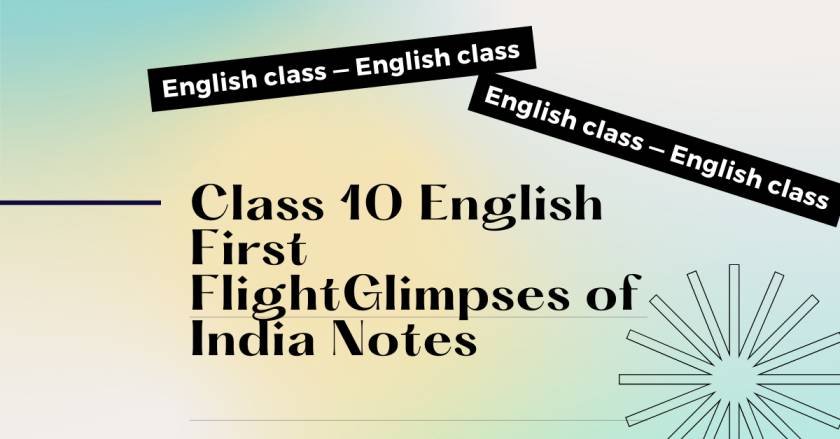www.free-education.in is a platform where you can get pdf notes from 6th to 12th class notes, General Knowledge post, Engineering post, Career Guidelines , English Speaking Trick , How to crack interview and lots more.First Flight Glimpses of India.
- First Flight Glimpses of India (In English)
- First Flight Glimpses of India (In Hindi)
- First Flight Glimpses of India (NCERT & EXTRA Questions and Answer)
(English First Flight Glimpses of India ) Summary In English
I. A Baker From Goa
Bakers of Goa known as Pader
In old Portuguese days, the people of Goa ate loaves of bread. Now these loaves have disappeared. But their makers are still there. The furnaces also exist there even now. The sound of the traditional bakers’ bamboo can still be heard. Someone of the family still carries this business. These bakers are known as pader in Goa even today.
Coming of the baker
The baker used to be the author’s friend and guide. He used to come twice a day. The sound of his bamboo woke the author and others from sleep. The author used to run to him for bread- bangles. The maidservants used to buy loaves and carry them inside the houses.
Delivering the loaves
The baker came with the jhang, jhang’ sound of his bamboo staff. One hand supported the basket on his head. The other banged the bamboo on the ground. The baker would place the basket on the bamboo. The author and others would look into his basket. They would eat the loaves with hot tea. They would not brush their teeth.
Importance of bread
The baker was very important for all occasions. Marriage gifts were meaningless without the sweet bread called bol. Sandwiches, cakes and bolinhas were made with the bread.
Baker’s dress
The baker or bread-seller of the past had a peculiar dress. It was known as the kabai. It was a single-piece long frock. It reached down to the knees. It is similar to half pants of today.
Baker—a happy family
The baker usually collected his bills at the end of the month. Baking was a profitable profession in the olden days. The baker and his family never starved. Their fat bodies showed that they were happy and were not poor.
II. Coorg
Coorg—a heavenly place
Coorg lies between the coastal town of Mangalore and Mysore. It is a very beautiful place like heaven. It must have come from the Kingdom of God. Strong men, beautiful women and wild creatures live in it.
Coorg’s weather and environment
Coorg or Kodagu is the smallest district of Karnataka. It has evergreen forests, spices and coffee plantations. Many visitors come to it between September and March. The weather is fine then. The air is full of coffee flavour.
People of Coorg—origin etc
The people of Coorg are of Greek or Arabic descent. The story goes that a part of Alexander’s army settled here. Its return became impractical. These people married among the locals. This culture is seen in the martial traditions, marriage and religious rites. The Arab origin is seen in the long, black coat worn by the Kodavus. It is known as kuppia. It is like the kuffia worn by the Arabs and the Kurds.
Coorg and its people
Coorgi homes have a tradition of hospitality. The people have many tales of bravery. Coorg | Regiment is one of the most decorated in the Indian Army. General Cariappa, the first Army Chief, was a Coorgi. Even today Kodavus are the only people in India to carry firearms without a licence.
Its wildlife
The river Cauvery gets its water from Coorg’s forests and hills. Mahaseer, the largest freshwater fish is found in these waters. Kingfishers, squirrels and langurs are found near these waters. Birds, bees and butterflies give one a good company here. Elephants enjoy being bathed here by their mahouts.
The landscape
The Brahmagiri hills give the climber a whole view of Coorg. A walk across the rope bridge leads to the sixty-four-acre Island of Nisargadhama. Buddhist monks from India’s Tibetan settlement live in Bylakuppe here. One can see them dressed in red, ochre and yellow robes.
III. Tea From Assam
Rajvir and Pranjol on way to Assam
Rajvir and Pranjol were travelling to Assam. A tea vendor called ‘chai-garam … garam- chai’. They took tea and sipped it. Rajvir told Pranjol that over 800,000,000 cups of tea are drunk everyday throughout the world.
Tea gardens seen
Rajvir looked at the beautiful scenery outside. Pranjol kept reading his detective book. There was greenery outside. Soon the soft green paddy fields gave way to tea-bushes. Tea-bushes spread as far as the eye could see. There were shade trees also over the areas. In the distance there was an ugly building. It was a tea-garden.
About legends behind tea
They were in Assam, the tea-country. Assam has the largest concentration of tea plantations in the world. Rajvir told Pranjol that no one really knew who discovered tea. There are many legends about it.
Chinese legend
A Chinese emperor always boiled water before drinking it. One day a few leaves of branches burning under the pot fell into the water. It gave a delicious flavour. These were tea-leaves.
Indian legend
Bodhidharma, a Buddhist monk cut off his eyelids because he felt sleepy during meditations. Ten tea plants grew out of his eyelids. These leaves when put in hot water and drunk, banished sleep.
Tea and China
Rajvir told Pranjol that tea was first drunk in China. It was as far back as 2700 B.C. Words like chai and chini are Chinese. Tea came to Europe in the sixteenth century. It was then drunk more as medicine.
Reaching the destination
Both of them dropped at Mariani junction. They were driven to Dhekiabari Tea Estate. On both sides of the road there were acres and acres of tea-bushes. Women with bamboo baskets were plucking the new leaves from them.
Rajvir’s knowledge about tea plantations
Pranjol’s father received them there. They had come there in the sprouting season. It lasts from May to July. It gives out the best tea. Rajvir told this to Pranjol’s father. He told Rajvir that he knew many things about tea plantations. Rajvir told him that he would learn more about them there.





